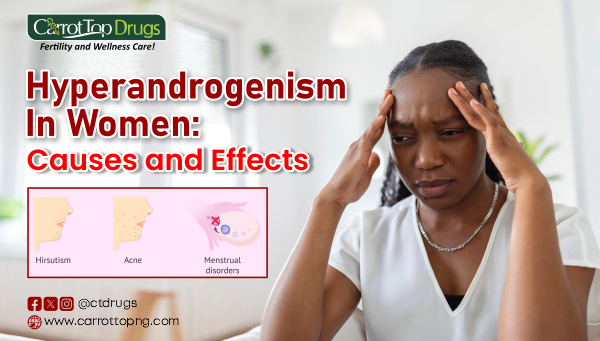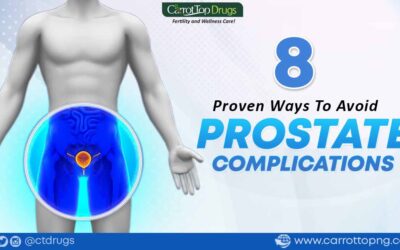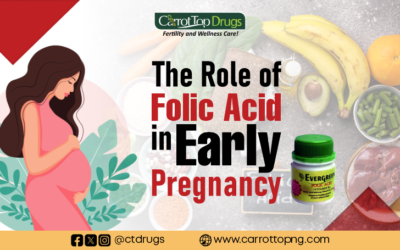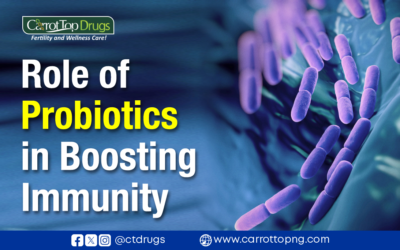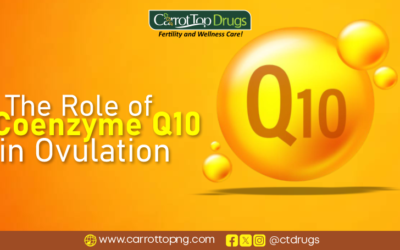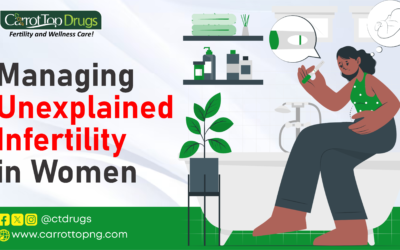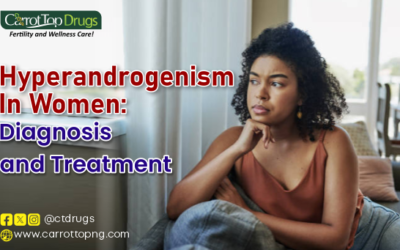Introduction
Hyperandrogenism in women refers to a hormonal imbalance characterized by elevated levels of androgens, often leading to various physiological and clinical manifestations. This condition, which can arise from multiple underlying causes, poses significant health challenges for affected individuals. From polycystic ovary syndrome (PCOS) to congenital adrenal hyperplasia (CAH) and other less common disorders, hyperandrogenism impacts reproductive health, metabolic function, and overall well-being. Understanding its prevalence, causes, and implications is crucial for effective diagnosis, management, and support for women affected by this condition.
Role of Androgens In Women
The role of androgens in women is multifaceted, influencing various aspects of physiological function and health. Despite being predominantly known as male hormones, androgens play essential roles in women’s reproductive, metabolic, and psychological well-being.
Reproductive Function:
Androgens contribute to the regulation of ovarian function and menstrual cycles in women. They play a crucial role in follicular development, ovulation, and the maintenance of normal reproductive physiology. Disorders such as polycystic ovary syndrome (PCOS), characterized by hyperandrogenism, can disrupt these processes, leading to menstrual irregularities and infertility.
Sexual Health:
Androgens are involved in libido and sexual arousal in women. They influence sexual desire, satisfaction, and overall sexual function. Adequate androgen levels are necessary for maintaining healthy sexual function and well-being.
Bone Health:
Androgens have a protective effect on bone density and strength in women. They contribute to bone formation and maintenance, reducing the risk of osteoporosis and fractures, particularly after menopause when estrogen levels decline.
Muscle Mass and Strength:
Androgens play a role in the development and maintenance of muscle mass and strength in women. They contribute to muscle protein synthesis and overall musculoskeletal health, influencing physical performance and functional capacity.
Metabolic Regulation:
Androgens influence metabolism, including glucose and lipid metabolism, in women. They can affect insulin sensitivity, adipose tissue distribution, and energy expenditure, contributing to metabolic health and the risk of conditions such as obesity and insulin resistance.
Mood and Well-being:
Androgens play a role in mood regulation and psychological well-being in women. They influence mood, cognition, and emotional stability, with alterations in androgen levels potentially contributing to mood disorders such as depression and anxiety.
Prevalence of Hyperandrogenism In Women
The prevalence of hyperandrogenism in women is a significant health concern, with various studies shedding light on its frequency and impact. Research suggests that hyperandrogenism affects a substantial portion of the female population, with estimates varying depending on the diagnostic criteria and study population.
One study published in the Journal of Clinical Endocrinology & Metabolism by Azziz, R., Marin, C., Hoq, L., Badamgarav, E., Song, P. found that approximately 5-10% of reproductive-aged women are affected by polycystic ovary syndrome (PCOS), one of the leading causes of hyperandrogenism. PCOS is characterized by hyperandrogenism, menstrual irregularities, and polycystic ovaries, contributing to the overall prevalence of hyperandrogenism in women.
Diamanti-Kandarakis, E., Kouli, C., Bergiele, A., Filandra, F., Tsianateli, T., Spina, G., & Zapanti, E. did another study conducted by the American Journal of Epidemiology reported a prevalence of hyperandrogenism ranging from 4.8% to 7.2% among women aged 20-44 years in the United States. This study highlighted the significant impact of hyperandrogenism on women’s health across different age groups.
Furthermore, hyperandrogenism is not limited to PCOS but can also arise from other conditions such as congenital adrenal hyperplasia (CAH) and androgen-secreting tumors. A study published in the European Journal of Endocrinology by Bidet, M. et al., indicated that CAH affects approximately 1 in 10,000 to 1 in 18,000 live births, contributing to the prevalence of hyperandrogenism in women.
The prevalence of hyperandrogenism varies globally, with factors such as ethnicity, genetics, and environmental influences playing roles in its manifestation. For example, a study by Teede, H. et al., studies have shown higher rates of PCOS and hyperandrogenism among certain ethnic groups, including South Asian and Mediterranean populations.
Causes of Hyperandrogenism In Women
Hyperandrogenism in women can arise from various underlying causes, each contributing to hormonal imbalances and excessive androgen production. Understanding these causes is essential for accurate diagnosis and effective management of hyperandrogenism in women.
Polycystic Ovary Syndrome (PCOS):
PCOS is the most common cause of hyperandrogenism in women, affecting approximately 5-10% of reproductive-aged women. It is characterized by ovarian dysfunction, insulin resistance, and elevated androgen levels. Women with PCOS often experience symptoms such as hirsutism, acne, irregular menstrual cycles, and infertility due to disrupted ovarian function and hormonal imbalances. PCOS is a complex disorder with genetic and environmental factors contributing to its pathogenesis, highlighting the importance of comprehensive management strategies for women with hyperandrogenism associated with PCOS.
Congenital Adrenal Hyperplasia (CAH):
CAH is a group of genetic disorders characterized by deficiencies in enzymes involved in cortisol synthesis, leading to excessive androgen production by the adrenal glands. In women with CAH, hyperandrogenism manifests early in life and can present with symptoms such as virilization, ambiguous genitalia, and menstrual irregularities. CAH is often diagnosed in infancy or childhood, but milder forms may present later in adolescence or adulthood, underscoring the need for early detection and treatment to prevent long-term complications.
Insulin Resistance:
Insulin resistance, commonly associated with obesity and metabolic syndrome, can contribute to hyperandrogenism in women. Elevated insulin levels stimulate androgen production in the ovaries, leading to hormonal imbalances and associated symptoms such as hirsutism, acne, and menstrual irregularities. Women with insulin resistance may also have an increased risk of developing PCOS, further exacerbating hyperandrogenism. Managing insulin resistance through lifestyle modifications and medications can help improve hormonal balance and reduce symptoms of hyperandrogenism in affected women.
Androgen-Secreting Tumors:
Rarely, tumors of the ovaries or adrenal glands can produce excessive amounts of androgens, leading to hyperandrogenism in women. These tumors, known as ovarian or adrenal hyperandrogenism, can present with symptoms such as virilization, hirsutism, and menstrual irregularities. Diagnosis typically involves imaging studies such as ultrasound or MRI to identify the presence of tumors and hormonal assays to measure androgen levels. Surgical intervention may be necessary to remove the tumor and restore hormonal balance in affected women.
Symptoms and Signs of Hyperandrogenism
The symptoms of hyperandrogenism vary depending on the underlying cause but often include:
- Hirsutism (excessive hair growth)
- Acne
- Irregular menstrual cycles
- Male-pattern baldness
- Weight gain
Effects of Hyperandrogenism In Women
Hyperandrogenism in women can have profound effects on various aspects of health and well-being, impacting reproductive function, metabolic regulation, and psychological health.
Reproductive Effects:
Hyperandrogenism in women can disrupt reproductive function, leading to menstrual irregularities, anovulation, and infertility. Elevated androgen levels, particularly in conditions like polycystic ovary syndrome (PCOS), can interfere with follicular development and ovulation, impairing fertility. Additionally, hyperandrogenism may contribute to the development of ovarian cysts and polycystic ovaries, further complicating reproductive health.
Metabolic Effects:
Hyperandrogenism in women is associated with metabolic disturbances, including insulin resistance, dyslipidemia, and obesity. Androgens can influence insulin sensitivity and glucose metabolism, leading to impaired glucose tolerance and an increased risk of type 2 diabetes mellitus. Dyslipidemia characterized by elevated triglycerides and low HDL cholesterol levels is also common in women with hyperandrogenism.
Endocrine Effects:
Hyperandrogenism in women can disrupt endocrine function, affecting the production and regulation of various hormones. Excess androgens can suppress the hypothalamic-pituitary-gonadal axis, leading to alterations in gonadotropin secretion and ovarian function. Additionally, hyperandrogenism may disrupt the feedback mechanisms involved in hormone regulation, further exacerbating hormonal imbalances.
Psychological Effects:
Hyperandrogenism in women can have psychological effects, including increased risk of mood disorders such as depression and anxiety. The physical symptoms associated with hyperandrogenism, such as hirsutism, acne, and alopecia, can contribute to feelings of self-consciousness, low self-esteem, and poor body image. Psychological distress related to hyperandrogenism may also impact social relationships and overall quality of life.
Cardiovascular Effects:
Hyperandrogenism in women is associated with an increased risk of cardiovascular disease, including hypertension, coronary artery disease, and stroke. Elevated androgen levels can influence vascular function, lipid metabolism, and inflammation, contributing to the development of atherosclerosis and cardiovascular complications. Managing hyperandrogenism and its associated metabolic risk factors is essential for reducing cardiovascular risk in affected women.
Conclusion
In conclusion, hyperandrogenism in women is a hormonal imbalance with significant implications for reproductive health, metabolic function, and overall well-being. In this article, we have examined the prevalence, causes and effects of hyperandrogenism in women. Taking our Evergreen Formular for Women, can help reduce hyperandrogenism in women.
FAQs
Q. What is hyperandrogenism in women?
A. Hyperandrogenism is a hormonal imbalance with elevated male hormone levels in women, leading to various physiological and clinical issues.
Q. What are the common symptoms of hyperandrogenism?
A. Symptoms include excessive hair growth, acne, irregular periods, male-pattern baldness, and weight gain.
Q. What are the underlying causes of hyperandrogenism in women?
A. Causes include polycystic ovary syndrome (PCOS), congenital adrenal hyperplasia (CAH), insulin resistance, and androgen-secreting tumors.
Q. What are the effects of hyperandrogenism on reproductive health?
A. It disrupts reproductive function, causing menstrual irregularities, anovulation, and infertility, particularly in PCOS.
Q. Can hyperandrogenism lead to long-term health complications?
A. Yes, it’s associated with metabolic issues, heart disease, and psychological effects like mood disorders and poor body image.
Q. How common is hyperandrogenism among women?
A. It affects a significant portion of women, with PCOS alone estimated to affect 5-10% of reproductive-aged women. Early detection and management are crucial for addressing its health impacts.

